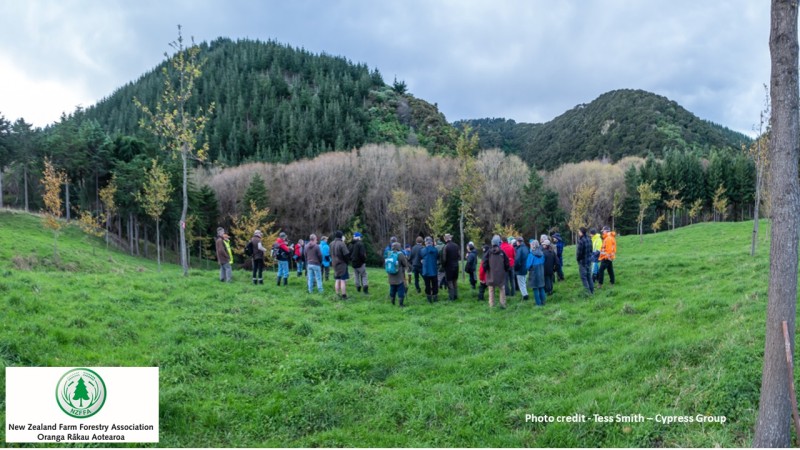NZFFA National Newsletter June 2025
Presidents Report
Dear NZFFA Member,
This is my first newsletter report since being elected as National President of NZFFA. It is a convenient way of sharing with you the work that your executive is doing. I am hopeful that I will be able to do this on a regular basis.
We are an association of regional branches and action group branches. You all belong to NZFFA through your membership with your respective branch. NZFFA exists because of its members and for its members. Your national executive has recently been focusing on many critical issues around membership and how to better serve our members.
I want to share with you some of the progress that we have been making within NZFFA.
At the recent Council meeting held at National Conference in Christchurch our executive member Jennie Marks ran a quick strategic review with the Councilors present. They had an opportunity to vote on a range of statements relating to how they viewed NZFFA. The results were emphatic with the following two statements getting large support:
“Supporting an organisation to influence how forestry and farming is done in New Zealand” and “Attending field days and seeing other people’s properties and forests”.
As a result of that, we are developing a refreshed strategy, which is with the Executive for review now and will be shared with all of you soon.
We have also pulled together a one-page pamphlet with information for new members. This explains who NZFFA is and has a QR code on it which should allow potential members to quickly and easily join NZFFA. This will be released before National Field days at Mystery Creek and hopefully will streamline the process of attracting new members and joining up.
We understand there has been frustration from some members around membership fees and other issues. This is not good from a membership organisation that must look after its members. I ask for your patience and pledge to continue to address these issues. While not making excuses, I will explain some of the reasons that these issues are happening.
In attempts to improve the service that members receive there have been several technology changes over time. This started a long time ago with the website. More recently the accounting package Xero was adopted. Quite recently there was a change to a membership system using Gecco. All of these have resulted in unintended consequences, some of which have disadvantaged some members. It has possibly been worse for NZFFA members given our demographic. Most of us do not adopt new technology readily so it can be a struggle, and I certainly fall into that category. We apologise for any issues, and I can assure you that we have been working hard to solve as many of them as we can.
The accounting package Xero has been worked on to sort out several glitches that have crept in over time. Some of these have created frustrating and embarrassing errors around membership payments and budget forecasts. We are relieved that these issues are being solved. Again, there will be communication coming to branch secretaries and treasurers soon about any changes.
In other news, the NZFFA website is having a complete makeover. This will be completed and available for use on June 30th , only about a month away! Again, I ask for your patience until then, but I am confident that all the work that Graham West put into driving this website improvement will be rewarded. When the refreshed website is operating, we will communicate some instructions to help all members get the best from it.
I am hopeful that the next time that I write for our newsletter I can talk about trees and not technology.
Regards,
Peter Davies-Colley
NZFFA - President
2025 Awards
Thanks to Stihl for their Sponsorship of the North and South Island Farm Foresters of the Year Awards. Click here to find out more about Stihl
Stihl North Island Farm Foresters of the Year Award presented by Mark Lochhead and Philip Ropiha to Stan and Jenny Braaksma.
Stihl South Island Farm Forester of the Year Award presented by Mark Lochhead and Philip Ropiha to Ian Jackson.
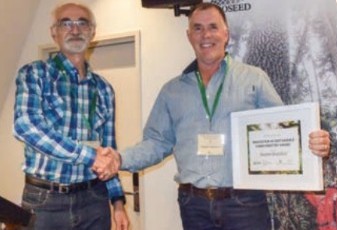
Stephen Brailsford with the Landcare Trust Award for Innovation in Sustainable Farm Forestry.
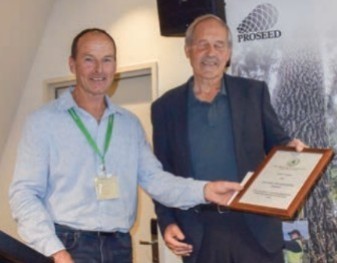
Ian Dewes from Wairarapa accepting the Michael Hay Young Farm Forester of the Year Award on behalf of Harry Livesey.
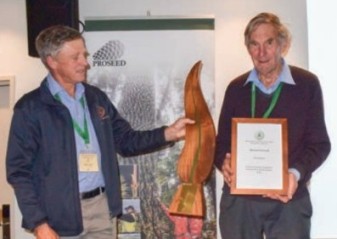
Michael Orchard with the Joll Hosking Award for the Distinguished Service Awards.
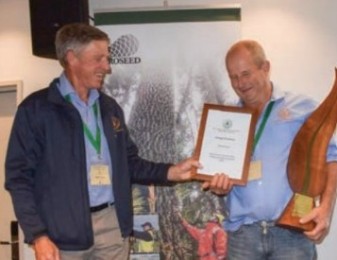
George Shallcrass with the Joll Hosking Award for the Distinguished Service Awards.
The trophy for Branch Excellence went to the Sequoia Action Group presented to Paul Silcock.
Presidents award goes to Ben Shallcrass
Appreciation award from South Otago branch to outgoing President Neil Cullen.
Field day Reports
South Island Agricultural Field Days
We had plenty of support on the stand at the South Island Agricultural Field Days held in Kirwee from the 26th to the 28th of March. (Ben, George, Vaughan, Barry Gray and Micheal Orchard from NZFFA and Sally Lee and Stan Braksma from the Poplar & Willow Trust). We had a great site in the Agricultural Marquee.
A lot of queries on what's the best shelter belts species and also lots of questions on planting poplar.
Dave Forsythe
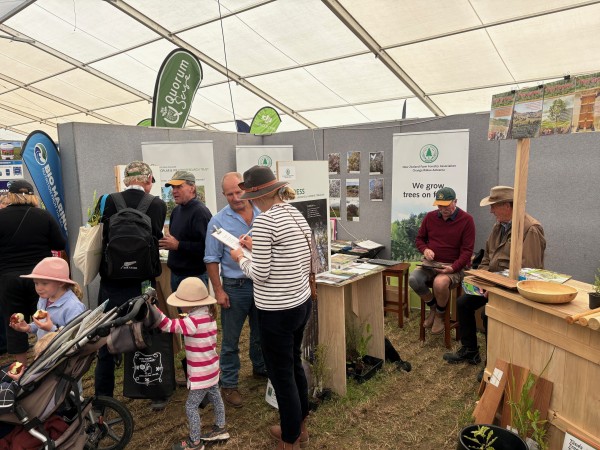
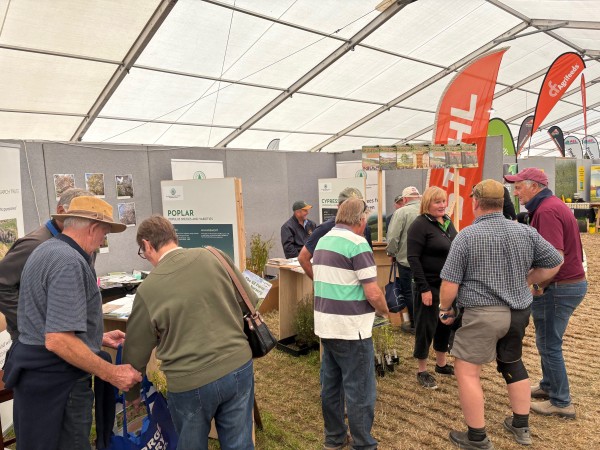
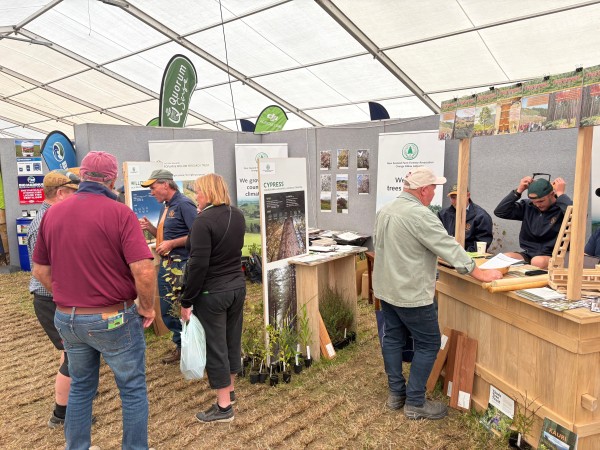
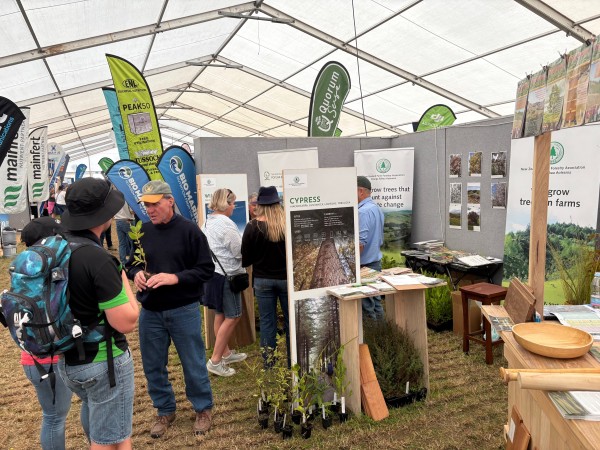
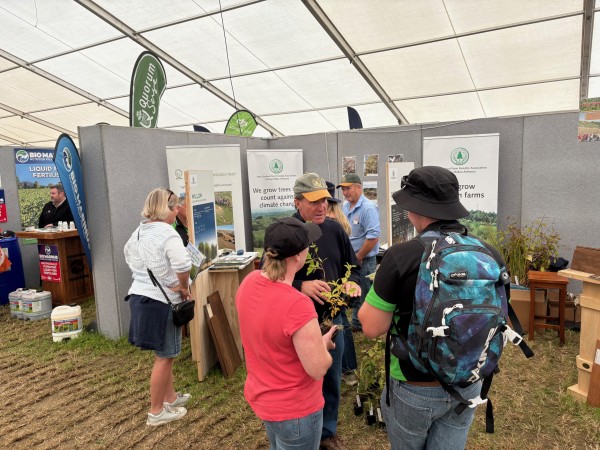
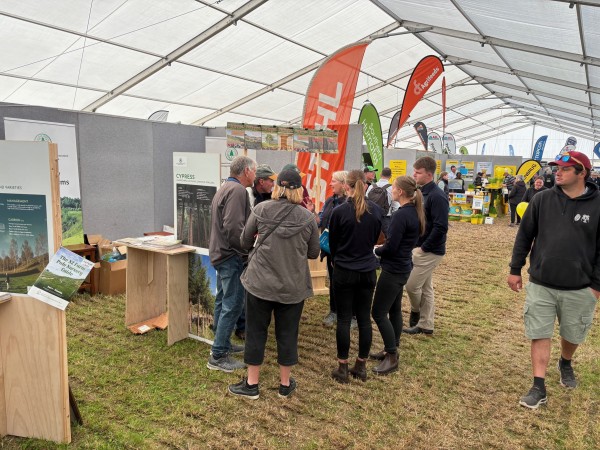
Central Districts Field Days
Ben, George and I along with Denis, Angus and also Sally from the Poplar and Willow Trust attended the Central Districts Field Days again.
We had a reasonably steady flow of people throughout the three days and estimated that we interacted with around 400 people over the three days.
Lots of Tree Growers and the Alternative Species books given away.
Lots of queries for poplar information and questions on what to plant for shelter belts. Possibly an opportunity for the local branch to organise a field day on this? We may also get these shelter belt queries at Kirwee.
A total of 124 people over the three days had a go on the Waratah simulator with also another 264 watching someone else on it over those days.
Dave Forsythe
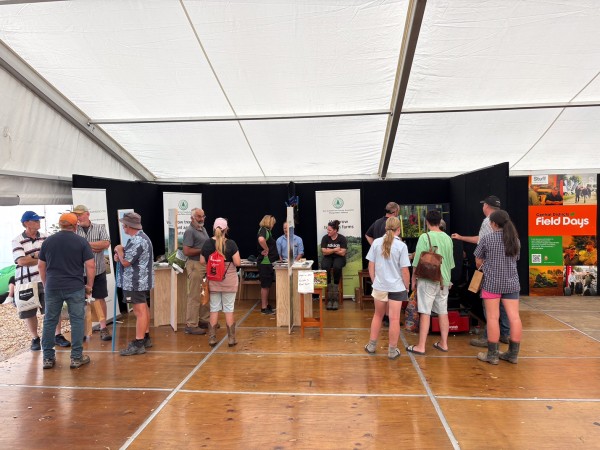
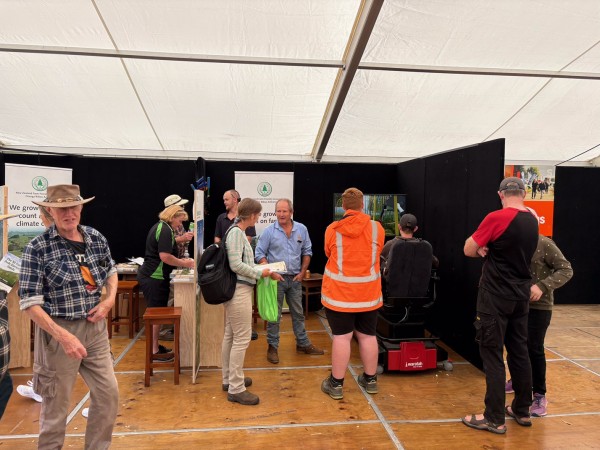
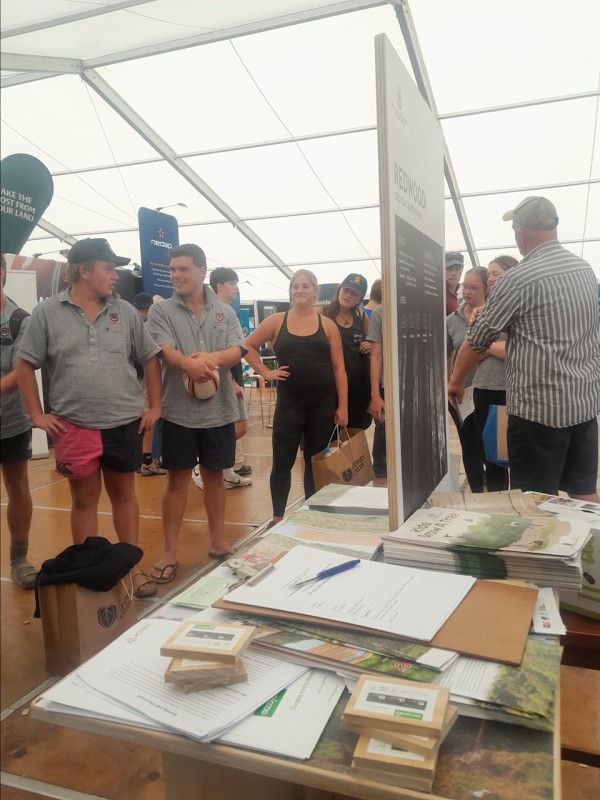
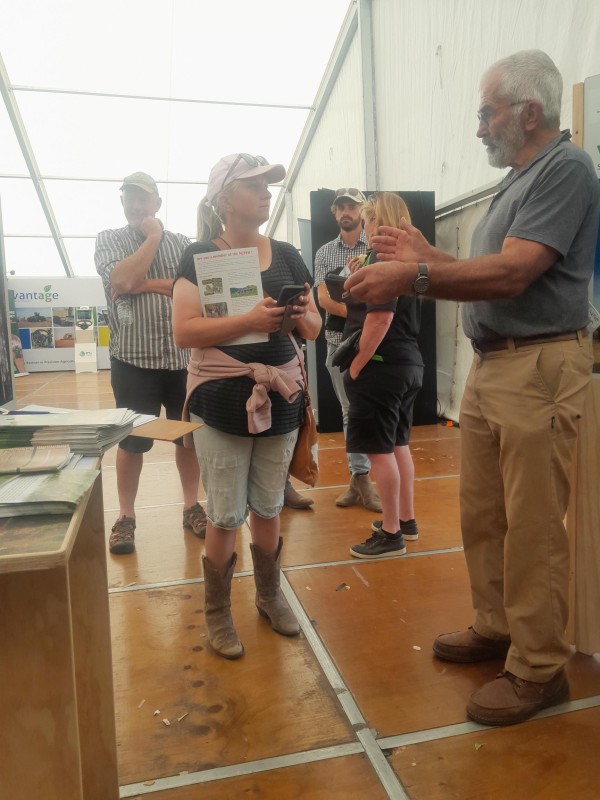
BOP Branch 7th March 2025, Waltons & Summerhills
Gabrielle, Andy and Tim Walton hosted the branch at Summerhills, a property in the Papamoa Hills adjacent to Te Rae of Papamoa (Papmoa Hills Regional Park). Summerhill is a privately owned, not-for-profit charitable trust dedicated to preserving a green space for future generations, in one of New Zealand's fastest growing districts. Their mission is to provide opportunities for recreation and education within a working farm and forestry environment.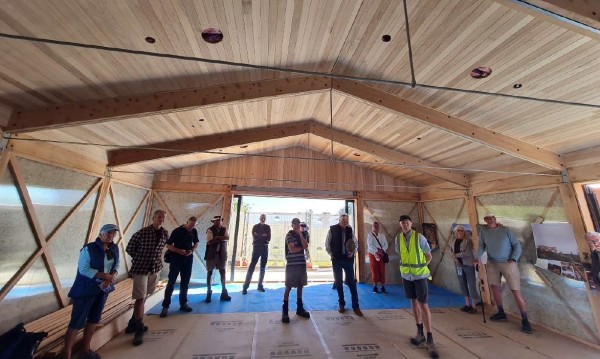
Summerhills Trust – community hub (under construction). Eucalyptus regnans sarking and wall cladding. Cypress and steel beams. Tim Walton in day glow jacket talking about the project.
Amongst cypress stand. Most blocks around 40 years old. 1ha annually harvested for domestic
& export markets. A manageable size for their sawmill & for the revegetation into natives. Timber
from such trees features in the community hub beams and exterior.
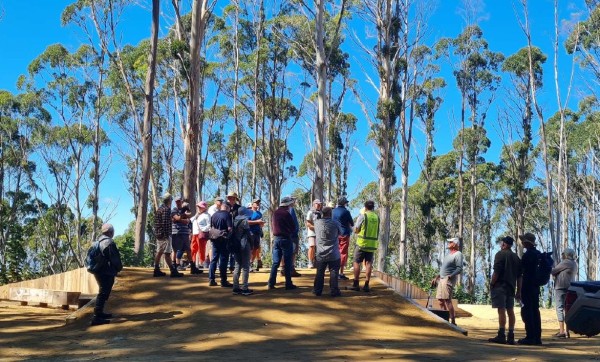
10inch Peterson Sawmill operating on skid site – cutting cypress. Telehandler heavily used and owned by forest owners (Waltons). Resulting timber, stacked and filleted. Significant grading occurs at this stage. Stacks are covered and initially dry in situ. Timber is sold direct to purchasers. After viewing a second sawmill, a trailer mounted woodmizer LT70, we relocated down to the Walton family home on the Tauranga Harbour edge. A barbecue lunch was provided by the branch (thanks FMG for ingredients. Sausages sourced from Mount Butchery for those who
asked).
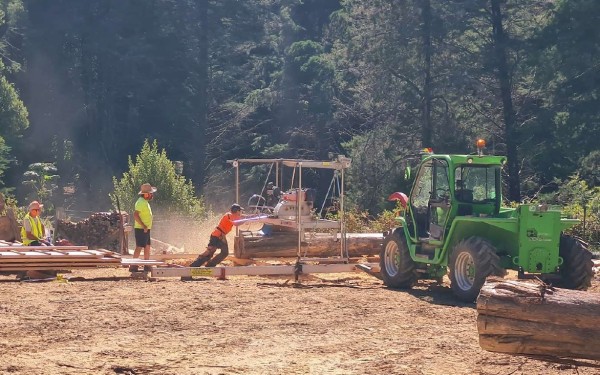
The Bay of Plenty Branch AGM followed lunch. Barbecue with ingredients kindly supplied by FMG insurance. Fed Farmers in attendance. The 2025 Committee is: Rita Bellamy , Richard Hart, Viv Barr, Jeff Tombleson, Martin Newnham, Charlie Low, and Graham West, as our National Rep. Graham updated us on national issues/ projects.
Following the AGM. Todd Cheesman spoke about supply chains in NZ with requested focus on specialist species. Todd is a director of Waipa Forest Management, a Rotorua based forest management business specialising in working with private forest owners. Todd is a member of the New Zealand Institute of Forestry and is a committee member of the Central North Island Wood Council. He reminded us the main work for forest managers, and contractors is very much radiata pine. Currently zero premium or discount of specialist species for most operators.
Bill Clark (eastern BOP) who works milling for small growers shared his experiences, and contributed to the specialist timbers discussion. Rik Hart mentioned; Mac Black who have a vertically integrated business in Whanganui (forest, milling, sales, and joinery), and also Graham and Tessa Smith who specialise in Paulownia timber (growing, harvesting and selling).
Gabrielle, Andy and Tim Walton spoke about their timber business Summerhill Timbers. More so then ever, New Zealand grown specialty timbers play an increasingly important part in expressing our culture and heritage.In early recognition of this we have been planting, growing, nurturing and professionally managing a range of hard and softwood speciality forests over the last 40 years. As they reach maturity the trees are hand-selected to be milled and then air-dried with no chemical treatment to retain the highest timber integrity for colour and strength.
Timbers now available are Lusitanica/Macrocarpa, Tasmanian Blackwood, Eucalyptus - Victorian Ash and Sydney Blue Gum. The rich and natural lustre of these timbers will excite and inspire your imagination to create finishes of striking elegance.
Branches and Special Interest Groups
Abies magnifica, the California Red Fir. Are you Cold Enough?
This is a high altitude tree in its home range of the Southern Cascade Mountains of Oregon and Western Coast ranges of California.
It is rarely found below 1500 metres (circa 5000 feet in the US)
But in New Zealand if appears quite at home at close to sea level.
What we do know is that it does best where the air is cool.
In the week leading up to the Canterbury Conference, a group of Farm Foresters took a break over on the West Coast. But before heading over Arthur’s Pass , we took time to explore the arboretum at Lake Coleridge. Some of the old trees there have gained enormous size.
But for me, one stood out as a sawmiller’s dream. A perfectly straight stem reaching for the sky and branches that were barely more than twigs. What was especially interesting to me was that this giant specimen was carrying cones.
I have learnt enough about the Abies genus to know that this can be a somewhat rare occurrence with some species. So I was determined to make a collection of seeds if it was at all possible. The true firs, the Abies family, carry their cones on the very top two or three metres of the trees. They also spread their seed as the cones disintegrate when they are “ripe”. The tree was too high to be climbed, so the only thing for it was to fossick around at the base of the tree to find the winged seed where we could. I had a great team of helpers and once we had our collective eye in, we managed to find a hundred or so, fresh and healthy looking seeds.
These will be sent to Appleton’s nursery at Wakefield where they will be stratified (placed in a fridge after being made damp) for a month or so . Then sown into forestry cells to produce seedlings for a new forest.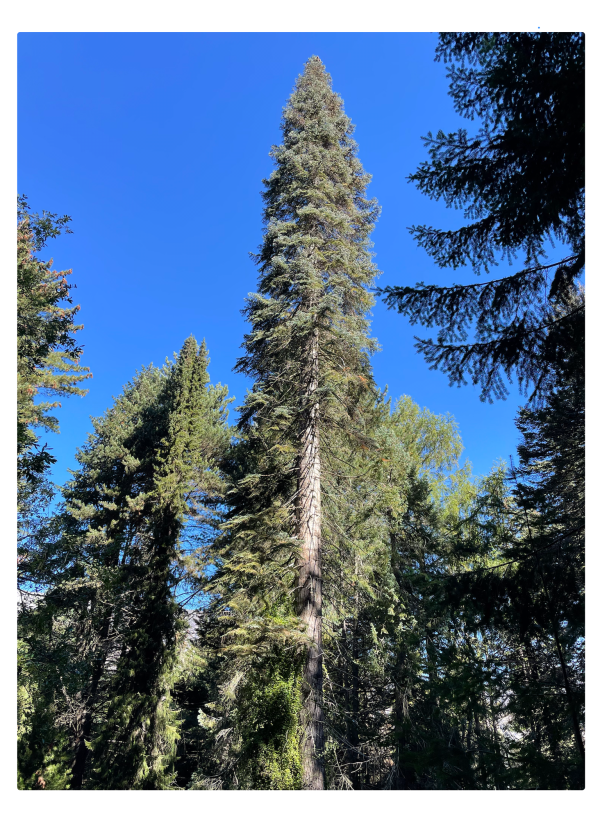
I hope that you are as impressed as I was, to view such a wonderful tree.
Vaughan Kearns of the Cypress Development Group.
Now batting for the other side.
AMIGO – who we are and what we aim to achieve
AMIGO is the Acacia Melanoxylon Interest Group Organisation, a Special Interest Group of the NZFFA. Set up to focus on Acacia melanoxylon (Tasmanian blackwood), we have recently widened our scope to include other acacias and robinias.
Our members are growers of blackwood and other interested parties, and as of May 2025 we have 69 members.
Our general objective is to bring together tree growers and forest researchers in an information-sharing network. We aim to share research findings, develop improved genetic stock, encourage the adoption of the best silvicultural techniques, and cooperate in a marketing strategy.
More specifically, we are currently working on finding a market in New Zealand for blackwood products – as growers want a return on their trees – and this will also have the benefit of reducing imported hardwoods.
Occasional newsletters and the odd field day also feature.
We are very happy to accept more members, so do join up – it only costs $5!
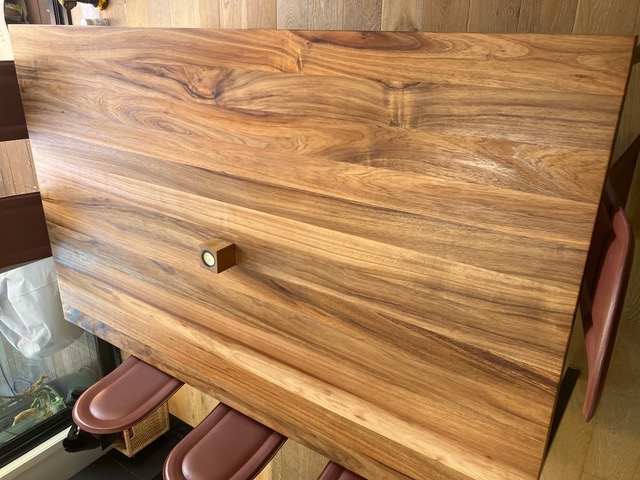
Members area
Africa: A Last Giant of the Rangitaiki Plains
Standing tall and solitary, "Africa" is a remarkable survivor among what was once a vast population of gum trees planted across the Rangitaiki Plains over a century ago. These trees, known for their remarkable ability to transpire water, played a crucial role in transforming the wetlands of the Rangitaiki into productive agricultural land. As part of a government initiative during the drainage and development of the plains, pioneering farmers were provided with seedlings of various gum species to assist in this enduring task.
Africa stands at the heart of the Barr Family Farm, which has been in the family since 1908. The farm is currently owned by Matthew and Genna Barr, with Matthew being the fourth generation to work this land. Africa was planted around 1920 by Matthew's great-grandfather, Alan B. Barr, a man who returned from the First World War with a deep appreciation for trees and a vision to bring life to the bare landscape he encountered.
The name "Africa" was given by Emma Barr, Matthew's sister, who thought it a fittingly monumental name for such a monumental tree. Today, this proud tree also holds a deep familial significance, as it now guards the ashes of both Jim Barr (Matthew's grandfather) and Alan J. Barr (Matthew's father).
The practice of planting gum trees along drains was common among the early settlers of the plains. However, these locations often led to the trees developing unbalanced root systems, anchoring them on only one side. When the Wahine storm struck in 1968, thousands of these gum trees, shallow-rooted and precariously perched along drains, toppled over. The fallen trees became invaluable as fence posts, firewood, and building timber.
Jim Barr, Matthew's grandfather, along with his friend Jack Goodrick, established a simple sawmill to process the timber from the fallen trees on the farm and in the surrounding areas. When Alan Barr returned to the farm in the mid-1980s, he continued the arduous task of clearing the storm's aftermath across the farm. After the mill had been dismantled Jim stored many sawn log “treasures” in the farm’s old barns.
Africa, along with a cluster of other gum trees, survived the Wahine storm thanks to the farm's relatively dry conditions and the strategic location of the tree. In the 1980s, one of the remaining gum trees was felled by a lightning storm while the dairy herd grazed nearby, resulting in the unfortunate loss of a prized cow. The timber from that fallen tree now forms part of the alterations to the original farm's homestead, where Matt and his family live.
Aware of the potential danger posed by the remaining trees, the decision was made to fell most of them and store the timber for a planned new house build.
Yet, Africa, the largest and most majestic of them all, was spared. Today, Africa stands proud and tall at 57 meters (measured three years ago), with a girth just under 5 meters. Her straight trunk rises to 17 meters before giving way to a billowing crown at 23 meters. She holds the distinction of being the tallest recorded tree of her species on the New Zealand Tree Register.
Africa is not just a significant feature of the Barr farm; she is a dominant landmark on the landscape of the Rangitaiki Plains, embodying the resilience and history of the land she has stood over for more than a century.
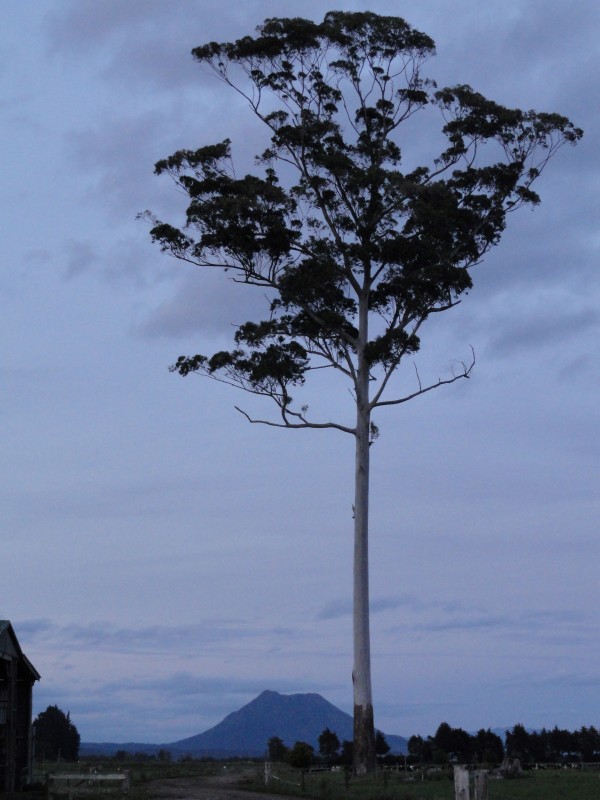
Submitted by Viv Barr (wife of Alan Barr, deceased, and mother of Matthew Barr, the current farm owner)
FORESTRY WINCH FOR SALE
Wallenstein Tractor Mounted Winch- FX85R https://www.wallensteinequipment.com/in/en/model/fx85r
Manufactured in Canada. Purchased new in Jan 2021 ex Taskpower Nelson.
Pull: 3855 kg
HP range: 30 to 60
PTO input: 540 rpm
Required Hydraulic Flow: 4 - 8 litres pm
Winch: mechanical, dry disc clutch
Line Speed: 29 – 72 metres /min
Cable type: steel (can be fitted with the same capacity but longer synthetic cable)
Cable length: 50m
Dimensions: 69 cm L x 102 cm W x 193 cm H
Total weight: 213 kg
PTO height: 41 cm
Mounting system: Cat 1
Max input torque: 360n-m
Max Bare Drum Pull: 3879 kg
Max Full Drum Pull: 1357 kg
Equipped: with a radio controlled remote clutch system. Enables stop/go/reverse/forward from the tree end of the operation while working. Ideal for one person as you can keep an eye on the towed load as it moves through your crop trees. More versatile is the use of 2 self- releasing snatch blocks ( supplied )
Full accessories: as per manual- snig chains, rope hooks, trailer hitch, PTO shaft cut to suit my tractor but easily replaced, remote control.
Extras: 2 self- releasing snatch blocks and strops rated for the cable and winch
New cost on delivery was $NZ 11,000 incl GST
Had little use- mainly thinning 20 year old Cypress block and general fire wood recovery
Was set up to work on 4WD, 40HP Kubota tractor which has since been sold.
Tractor Requirements:
30 to 60 HP, rear hydraulics or similar supply for clutch operation and 12V supply for remote.
Background:
This was an excellent unit to have and suits a farm forestry setup very well, especially with alternative species (it is not a 30 yr old Radiata harvesting setup!) . I was surprised what it could do with 40 HP available.
It has been looked after and is in excellent condition
My only regret is that I did not purchase it way earlier than I did as it saved an awful lot of manual effort.
Full manual and instructions and I am happy to provide advice on operation.
We have sold our property and this winch is currently stored in a shed and available for inspection to be sold, as is, with all accessories. I am prepared to do a deal on this machine. Price on agreement.
Laurie Bennett
0272047026
Obituary John Millett
John Millett
An appreciation by Nick Ledgard
I have known John Millett for around 70 years, and have many good memories of our times together. He was a few years older than me, and I went through school together with his younger brother, Richard. In the early days, I did not see a lot of John, because soon after he completed his education, he became deeply immersed in getting his farm up to speed near Warkworth. We used to go up there on occasions to shoot a few goats, and for bachelor overnighters in his rather Spartan home. John’s cooking was always basic.
I spent my working life in forest research, and was always aware that John had a keen interest in trees, which he demonstrated via a lot of planting on his farm. It became well known for establishing and maintaining ‘the right tree in the right place’. I always learnt a lot when visiting him, as he was an excellent observer and absorber of information. His immaculately straight fences incorporated locally grown totara posts, and over time he learnt that the slower-growing rough-looking stems on his ridges lasted much longer in the ground than the faster-growing, impressive-looking, straight stems in the valley bottoms. John had worked that out for himself, and I later learnt that this is exactly the same with native timbers in S. America’s Patagonian hill country. John (together with his distinctive and colourful jerseys) became a well-known member of the NZ Farm Forestry Association, and regularly attended their annual conferences – where 3 or 4 of us usually shared accommodation. We quickly got used to avoiding frustration by allowing extra time for his slow morning rise and breakfasting routine.
John never travelled overseas before he sold his farm, but became a regular offshore traveller thereafter. At our annual farm forestry gatherings I used to look forward to hearing of his latest offshore adventure. His great observation and narrative skills made for fascinating listening (although not so much so with his hundreds of photos, as he refused to delete the worst – and there were a few of those). Many farm foresters will recall the Wellington conference when he spoke to all of us about a recent boat cruise along the eastern Russian coast, and sang a song he had written for a lady-friend he had met and was liaising with on the Kamchatka Peninsula. This conference presentation received much deserved and warm applause. John was a keen amateur dramatist, loved musicals and had a great voice.
Apart from farm forestry occasions, John used to annually travel south in the autumn, and he and I would head out hunting for a few days in the local hills. Needless to say, we both really enjoyed those excursions, even if they were not always successful from a trophy gathering point of view.
On one such visit 30+ years ago, he commented that a block of eucs I had planted needed thinning. So when I went to work the next day I gave him a chainsaw and said ‘Go for it’. On returning home, I was amazed/alarmed to see so many stems on the deck, told him as much, and almost suggested that he head back north. However, it did not take long for me to realise that he had actually done just what was needed. About that time, he gave me a pair of side-cutter pliers, which still occupy the dominant peg above my work bench. Arguably, they would be the tool I have used most about the property - a practical gift from a very practical person.
John was one of those one might describe as a ‘background’ person, who did not stand out at first look, so it often took time to get to know him. But once you did, you quickly got to appreciate his character and many attributes, and looked forward to catching up more. I saw this a number of times as he became well-known in farm forestry circles. He was certainly a great mate of mine – in actual fact, the one I have known the longest.
Fond farewells, John.
Edward John Upton Millett (John).
5th March 1940 – 30th April 2025
A few days ago, one of the stalwarts of the Lower North Branch of NZ Farm Forestry Association, John Millett, passed away.
John was first and foremost a farmer but soon also became an enthusiastic forester and outside of these more important aspects of his livelihood also a thespian, artiste, botanist, craftsman, fisherman and hunter - and usually several of these at the same time. Friends and Association members will remember John for the regularity of his attendance at field days and conferences, his thoughtful questions, bright cardigans and willingness to burst into song whenever an opportunity presented itself. He was a favourite at annual conferences where for several years branches were asked to contribute an item of entertainment to the evening after dinner programme - and lower North leaned heavily on his abilities.
Meeting John for the first time he appeared quiet and reserved but that simply reflected a very attentive and thoughtful mind – and later in life colleagues often remarked that John often knew more about many facets of forestry than they did.
John’s education started at Takapuna Primary School, Kings Preparatory School and Kings College (where he was a boarder from the age of 11 years), before attending Massey University to widen his farming knowledge. He then acquired his farm in Whangaripo Valley near Wellsford, a somewhat underwhelming dairy farm which he developed and expanded as a high-quality sheep and fat lamb enterprise. A key part of this development was the introduction of trees and forests for the range of values he considered important on his property – shade, shelter, aesthetics, biodiversity and of course wood production. A range of species was grown and John incorporated some of the knowledge and techniques he learnt from his NZFFA friends, and he soon began to assemble a collection of timbers from his favourites, both native and exotic.
Whangaripo Valley farm was his home for 37 years and it was recognised as something of a model farm with care being given to matching land use to the natural features of the property.
Family and friends also noted that John was always keen to go fishing and hunting, although it was further noted that he had a propensity to stay out until he was satisfied he had caught/shot his quota – which sometimes meant long days. And he also became a man of great faith – his church involvement, roles in the local operatic society and associated singing lessons was another side to John that many of us didn’t realise at first but which was possibly reflected in his calm temperament and happy demeanor.
After farming John moved to Brick Bay, part of Snell’s Beach and looking out towards Kawau Island. Although no-longer a farmer john maintained all of his other interests, although he now had more time to travel and made many trips to other countries and places of interest, often in association with a forestry conference or tour and he was happy to share his experiences upon his return. He became a keen photographer although an offer to “share 1 or 2 pictures” could result in receipt of a file of 300-400 shots, taken from almost every angle.
When he made the shift to Brick Bay he was accompanied by his large store of collected timbers and he soon had a workshop set up producing some excellent furnishings for family and friends – one request for some totara uncovered a number of large flitches including some beautiful heart that John said he had cut more than 30 years ago.
John was marked by an approachable and open attitude and a willingness to help if he could. But alongside this his commitment to his interests were notable for being focused and steadfast – his was the archetypal approach to “if a job is worth doing then it is worth doing well”.
Peter Berg, 9th May 2025.
Events
Mystery Creek Fieldays, Hamilton
Mystery Creek Fieldays is the Southern Hemisphere’s largest agricultural event and the ultimate launch platform for cutting edge technology and innovation.
11 — 14 June, 2025
Wed, Thurs, Fri 8:00am to 5:00pm
Super Saturday 8:00am to 4:00pm
Click here for more information
Northland Farm Forestry Field Day
Northland Farm Forestry Field Day – Thursday 12th June, 10:00am
It’s a nursery, a big one, and pretty modern too with some fancy automation.
After-lunch walk along a new walkway at Mangawhai, plenty of café options.
Kauri Park Nursery, Kaiwaka & Mangawhai Harbour walkway
Topics: It’s a nursery, a big one, and pretty modern too with some fancy automation.
After-lunch walk along a new walkway at Mangawhai, plenty of café options.
Date & Time: Thursday, 12th June – 10:00 am.
Location: Nursery – 2180 State Highway 1, Kaiwaka Harbour walk – Molesworth Dr & Centreway Rd roundabout (parking options nearby)
Parking: Parking at the nursery is limited so please ride share! See photo below for parking location.
Directions: Kauri Park is easy to find on SH 1, just 2.2km north of Kaiwaka on the right.
Directions for the after-lunch harbour walk will be given on the day.
What to bring: A foldable chair, sturdy footwear, wet & windy weather gear, lunch, and drink.
Health & safety: The nursery has a full H & S protocol, and we will be strictly abiding by it.
Introduction: From the Kauri Park website: https://www.kauripark.com/
Kauri Park Group is New Zealand's largest wholesale native and urban landscaping plant nursery. From humble beginnings our growth has been borne from our mission to rejuvenate and regenerate New Zealand’s landscapes into thriving ecosystems. As we’ve grown over the last 30 years we’ve expanded into eco-sourcing, propagating, growing, supplying, planting and maintenance of nationwide regeneration projects at scale, all the while staying true to our mission and commitment to New Zealand and our growing partners. We do this by delivering an outstanding customer experience, consistent quality and adapting to our partners’ needs. Your growth is ours.
Programme:
10:00 – Park in the area indicated and await the tour guide for H & S and tour programme.
10:15 – Begin nursery tour
11:45 approx – Lunch (bring your own foldable chair if you have one)
12:30 – Depart for Mangawhai where Gordon Perry will show off a new walkway along the harbour front.
1:00 approx – harbour front walk (at your leisure or stay with Gordon as he recounts the project and gives some local history)
2:00 – plenty of café options for that well-earned coffee or tea fix
West Coast Branch NZFFA Field Day 26 July
Save the date!
Field Day in Grey Valley
West Coast Branch are planing a Field Day in Grey Valley on the 26th July, starting at 10.30 am.
Further details to come.
Conference 2026
Waikato 2026
The Waikato branch is looking forward to welcoming you to the 2026 conference, from Monday 20th to Friday 24th April, and based in Cambridge.
We are sticking with a traditional format, with 2 days of meetings and speakers, including an opening dinner on Monday and the Awards dinner on Tuesday night. We’ve allowed all day Monday for Special Interest Groups meetings, and the Council meeting and AGM on Tuesday. For partners and others not wishing to attend the meetings, we have a local excursion on offer.
Then 3 days of field trips, firstly near Cambridge with a native focus, then a day further south in the radiata heartland of the North Island. The third day we’ll see a successful niche timber business integrated into a dairy farm, and then a property where 2 generations of farm foresters will show us cypress trials, oaks and redwoods.
See you there!
